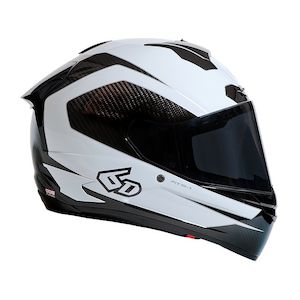Amateur racing creates strange machines. The reason, in case you haven’t spent much time in the pits at a club race, is that unlike pro racing, where professionals design and prepare the bikes, amateur racers do most of it themselves. Imagine Thursday night softball, if everyone playing made or modified their own bats.
People have some funny ideas of what makes sense, and in club racing that’s exactly what leads to mufflers pointing in every direction, questionable aerodynamics, and seats made from Home Depot products. I am not above this. In fact, it is how I grew up. I have been one of the mad masses filling a racing paddock, scruffy leathers and a seat attached to the bike with a hinge my dad bought at a hardware store. I digress.
All of that is why most people stick with stalwart race platforms like the Suzuki SV650, Kawasaki Ninja 400, and inline-four sport bikes. But once in a blue moon, someone has a new idea with true potential. Someone like Markus Kramer.
The history and tech of the Kramer HKR-EVO2 R
A German engineer with a taste for single-cylinder racing (specifically the European Supermono Cup), Kramer and two colleagues designed the original HKR in 2009, starting with a KTM 690 engine in a custom frame, and spent four years developing the machine. The second iteration of the HKR, dubbed the EVO2, sits before you. It was enough of a success that people wanted to buy HKRs for themselves. And so the movement has grown. When I gridded up for American Historic Racing Motorcycle Association (AHRMA) racing at Laguna Seca last month, there were at least half a dozen other Kramer HKR-EVO2 machines taking the green flag in each of the two classes I entered. More on that in a minute.
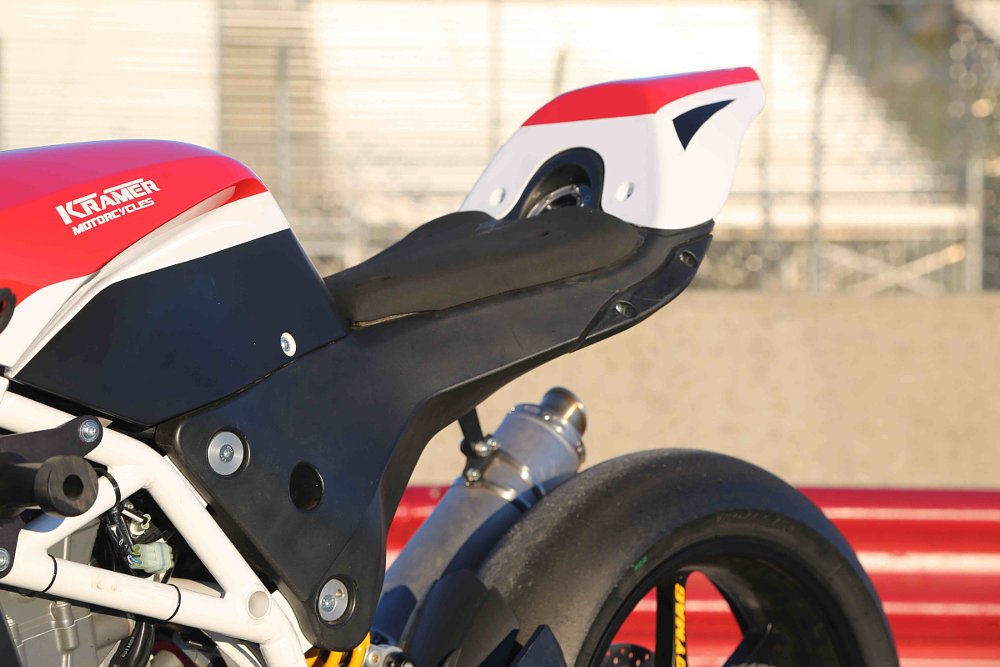
The beating heart of the HKR-EVO2 remains KTM’s over-the-counter 690 cc single-cylinder engine used in the 690 Duke. The mill has gotten more advanced since 2009, but the architecture is similar. Almost every other piece on the bike, though, is either custom or pulled from the shelf of a race shop. The steel-trellis frame, 3D-printed front subframe, bodywork, and swingarm are all custom parts made just for the HKR-EVO2. Items like the brake rotors, wheels, clip-ons, and steering damper are sourced from competition companies.
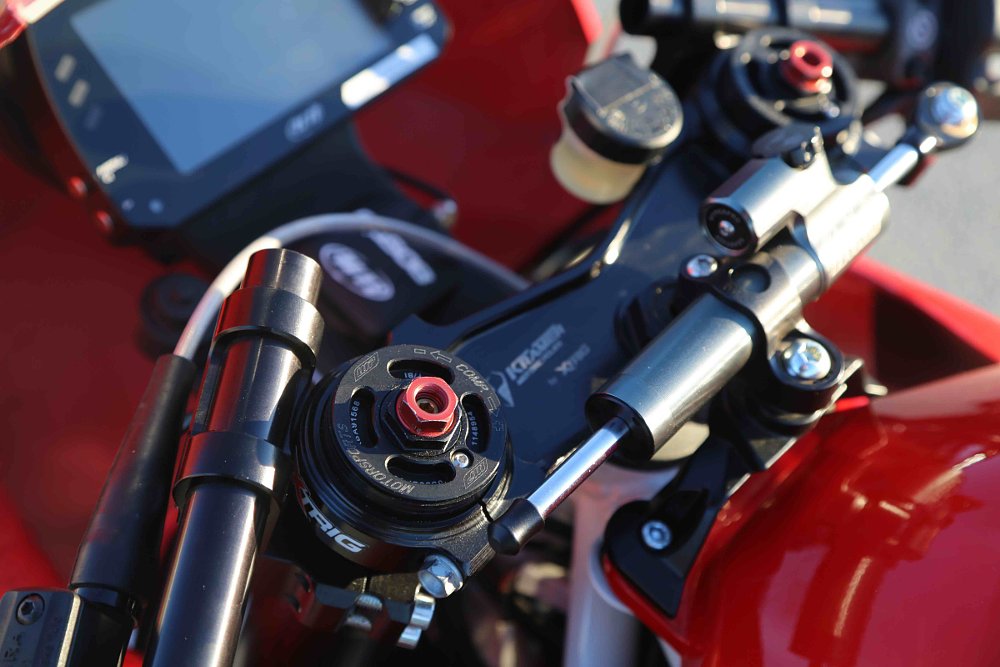
Many other parts are under constant development. The dash on this bike, for example, is a TFT unit being tested for upcoming models, and the auto-blip downshift function on the quickshifter is a relatively new batch of code in the ECU that’s still being tweaked. (If you purchase an EVO2 R, an up-only quickshifter and a two-color LCD dash are standard.) All of this adds up to a total weight of 275 pounds with a half-tank of gas, and 80 horsepower on tap. For context, that’s about 40 pounds lighter than a stock Honda CB300R, with triple the power.
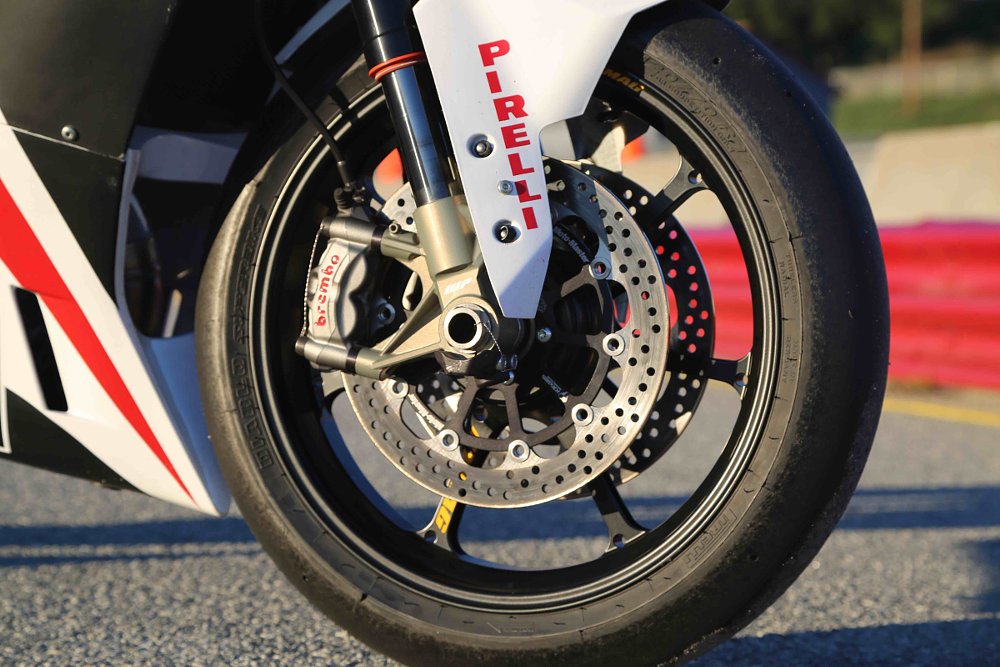
Oddly, for all of the nifty little items that make up the Kramer, from the radial-pull Brembo master cylinder to the forged-aluminum Dymag wheels, none of them were the first thing I noticed climbing aboard this HKR-EVO2 for the first time. Instead, the two things that struck me were how narrow it is and how decent the fit is for a normal-sized human being. Unlike old GP bikes that were often designed to fit Japanese and Italian teenagers, the Kramer uses racey-but-reasonable ergonomics. The seat-to-peg distance is sensible and the clip-ons are set wide for a commanding riding position. Thumb the starter and the engine jumps into a fast idle, akin to a 450 motocross bike. That’s thanks in part to adjusted ignition timing, but also simply being a large, oversquare single.
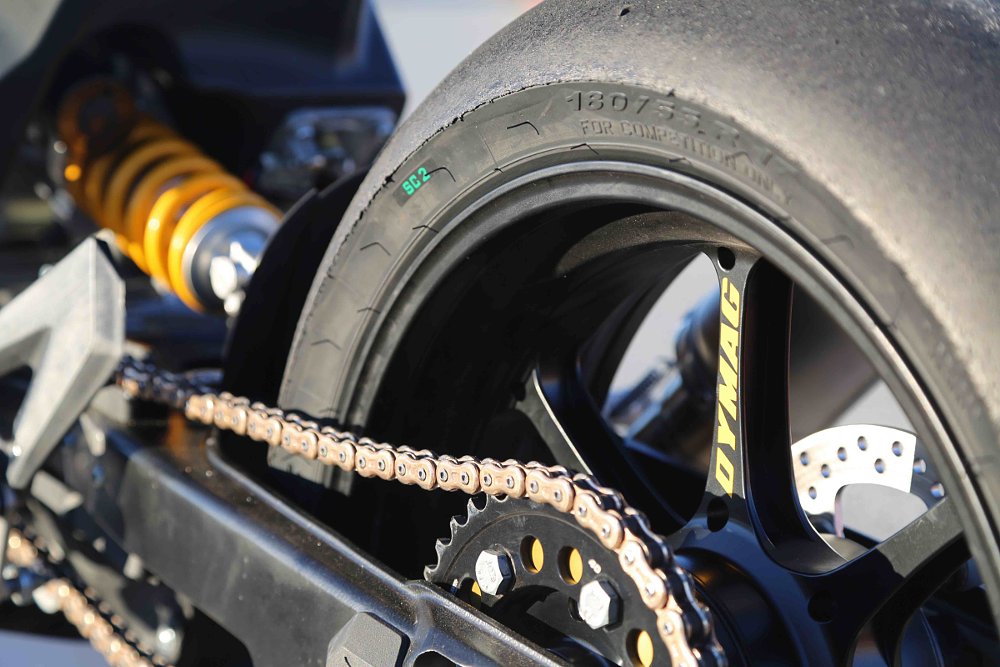
As I trundled down pit lane to attack my first practice session, the dynamic of the machine reminded me very much of a basic, 690 Duke. It’s less comfortable, sure, but it chugged along happily at jogging speed until I rolled the throttle on to join the racing surface. A salvo of singular exhaust notes fired out of the pipe and lifted the front wheel effortlessly in first gear. A drop of the boot onto the GP-pattern shift lever and the Kramer popped up a gear to ride the smooth, flat curve of torque until it was time for the next gear.
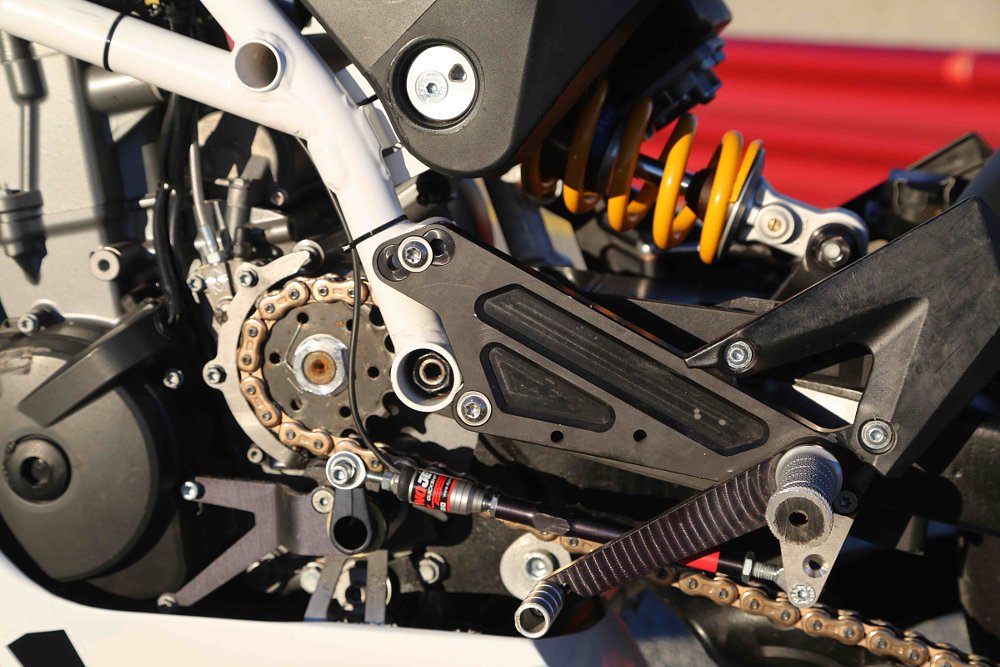
The learning process is made easier because the engine is so agreeable. One gear too high exiting the Corkscrew? No big deal, the Kramer just thumped down the hill toward Rainey Curve and stoically hoped I would remember to grab another downshift next time around. For an amateur racer, everything is already happening too fast to keep up, so a bike that meets you halfway can be a huge asset.
I was far from perfect but practice was complete. It is no surprise that the Kramer HKR-EVO2 is a treat for a track day or a practice session. But as anyone who has done it will tell you, gridding up to race is a different story. The venom of competition in one’s veins can overwhelm the calm and thoughtful self that survived the practice sessions so cooly. Some people call it the red mist. However you couch it, I am often a victim and it sometimes feels like bikes get “worse” in a race because the fire to win burns too hot. So the real test would come when the flag dropped.

Racing the Kramer HKR-EVO2 R
The challenge set before the Kramer and me on this occasion was AHRMA’s Sound of Thunder class. Most of the other machines lined up were either other Kramers — there were at least half a dozen others on the grid — or air-cooled Ducati twins in various states of tune. Some Davids and some Goliaths, in other words, and that meant the classic race-track showdown of heavier, more powerful bikes versus the Kramer’s light-and-agile approach.
Sadly, racing started with a slew of red flags. It was cold, and maybe people were overly excited to race at the famous Laguna Seca. Or it was too windy. In any case, my competitors and I put on a fine demonstration of why we are not professionals.
The post-red-flag restarts raised some other issues. A handful of restarts in a row can be a worry for some racing machines with finicky clutches, because they're extremely hard on clutch plates. The HKR-EVO2’s secret weapon here is a bone-stock KTM engine with a robust clutch. Meaning it’s hard to roach the clutch, and even if you do it would be available to order (or be in stock) at a KTM dealer. The sticky, slick, Pirelli race tires had the opposite problem in the 50-degree temps which, unlike the heads of my fellow racers, were cooling too quickly. And that brings me to some of the things about the Kramer that are not as easy to love.
I learned that cold and windy weather is especially tricky for the HKR-EVO2 precisely because it is so light. Even with tire warmers, I had a little trouble keeping heat in the tires, which meant the grip level was questionable. Once that was overcome, the wind was also a challenge because of the Kramer’s low curb weight. There are plenty of benefits, too, but a sub-300-pound race bike certainly requires a lighter touch and more diligence in a crosswind. Last of all, if something catches you out and it ends with a lowside into the gravel trap, keep in mind that the stock componentry basically ends at the engine. Meaning if a footpeg breaks off you’d better have a spare, because your neighbor with an SV650 probably won’t be able to help.

All of that said, it’s important to note that the Kramer’s responsiveness saved it. Even though the tires cooled more than I expected and yes, I lost control of the front end in turn three on one of many restarts, the bike offered enough feedback and poise to keep me off the ground. I just stayed calm and the slide came back to me; not every bike offers that kind of forgiveness.
When racing finally steadied out, the HKR-EVO2 proved that practice was not a fluke. The bike held a line like a compass locked off on a sheet of graph paper, and the controls were so intuitive they became second nature. In short, all of the reasons it was easy to ride in practice make it just as easy to ride in the heat of battle. It is as comfortable, predictable, and rewarding to race as any machine I’ve ever tested. Even Ducati’s Panigale V4R or Honda’s MotoGP-replica RC213V-S, performance machines of epic proportions, didn’t build my confidence as quickly as the Kramer.
If you’re thinking, “Those bikes are viciously fast,” I would say that has something to do with why they aren’t as forgiving. The HKR-EVO2 is manageable and easy to control for mere mortals, which is something that truly matters and is often overlooked by racers. The result at Laguna Seca was crossing the finish line first in each of the three races that weren’t red-flagged, and in one case the entire podium was made up of HKR-EVO2 machines. A whole grid full of these things would be a riot. MotoAmerica, I’m looking at you.
The last bellyache about the Kramer HKR-EVO2 R is arguably the asking price, which for 2020 stands at $22,495. For street riders, it seems insane, and I’m sure some of you will shout about it, but around the racing paddock the MSRP is typically met with a slow nod. That’s because anyone who has prepared and raced a 600 cc supersport machine (or even a middleweight twins racer) to this level knows that it’s amazingly easy to spend $20,000. And the customer base agrees. Despite having an amazingly similar “S” spec available for about $17,000 for the past few years, the “R” model has outsold it by a ratio of 24:1.

Amateur means for the love of the game
My grandmother loved the Olympics because many of the people competing have jobs. Mainstream sports like basketball, hockey, or tennis are mostly pros with trainers and nutritionists. The more ancient, and sometimes obscure, sports are often contested by lawyers, writers, and teachers. That same sentiment is the reason this Kramer HKR-EVO2 is such a compelling machine to take on a racetrack — it is a normal, everyday engine pulled from a sub-$10,000 street bike, tuned and sculpted into one of the most capable track machines available.
The Kramer is exotic, but somehow not extreme, and the payoff for deliberately making a user-friendly racing machine is massive. Grand Prix machines of yesteryear (think 125 cc and 250 cc two-strokes) are amazingly capable but also famously unforgiving. The HKR-EVO2 is easy to ride, slowly or quickly. It rewards you for riding well but doesn’t punish you for making small mistakes. The beating heart of a blue-collar commuter makes it lovable — unintimidating without being timid, and thrilling without being fast. It doesn’t chew through tires or need special gasoline. It’s not a torture rack to ride and it carves corners like an Olympic skier.
Racing a late-model Kawasaki Ninja 300/400 or a 15-year-old Suzuki SV650 is undoubtedly cheaper, and that’s what most experienced amateur racers would recommend, surely. However, when the time comes for a race-ready track weapon, it would be silly not to consider a Kramer.

 Membership
Membership









